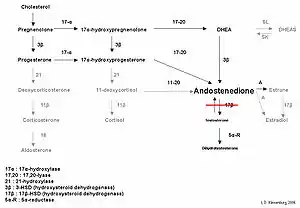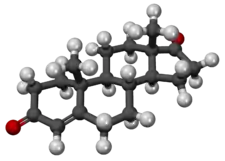17β-Hydroxysteroid dehydrogenase III deficiency
17β-Hydroxysteroid dehydrogenase III deficiency is a rare autosomal recessive disorder of sexual development condition that is a cause of 46,XY disorder of sex development (46,XY DSD). The impaired testosterone biosynthesis by 17β-hydroxysteroid dehydrogenase III (17β-HSD III),[6][7] presents as atypical genitalia in affected males.[8]
| 17β-Hydroxysteroid dehydrogenase III deficiency | |
|---|---|
| Other names | 17 alpha ketosteroid reductase deficiency of testis[1] |
 | |
| Biochemical effects of 17β-hydroxysteroid deficiency-3 in testosterone biosynthesis. Typically levels of androstenedione are significantly increased, whilst testosterone levels are decreased, leading to male undervirilization. | |
| Symptoms | Hypothyroidism, Cryptorchidism[2] |
| Causes | Mutations found in the 17β-HSD III gene[3] |
| Diagnostic method | Genetic testing[4] |
| Treatment | Gonads should be monitored(possible malignancy)[5] |
Signs and symptoms
17-β-Hydroxysteroid dehydrogenase III deficiency is a cause of 46,XY disorder of sex development (46,XY DSD) that presents in males with variable effects on genitalia which can be complete or predominantly female with a blind vaginal pouch. Testes are often found in the inguinal canal or in a bifid scrotum. Wolffian derivatives including the epididymides, vas deferens, seminal vesicles, and ejaculatory ducts are present.[8]
The autosomal recessive deficiency arises are a result of homozygous or compound heterozygous mutations in HSD17B3 gene which encodes the 17β-hydroxysteroid dehydrogenase III enzyme, impairing of the conversion of 17-keto into 17-hydroxysteroids. The enzyme is involved in the last phase of steroidogenesis and is responsible for the conversion of androstenedione to testosterone and estrone to estradiol. Virilization of affected males still occurs at puberty.[8]
Genetics
17β-Hydroxysteroid dehydrogenase III deficiency is caused by mutations found in the 17β-HSD III (17BHSD3) gene.17β-HSD III deficiency is an autosomal recessive disorder.[3][9]
Biochemistry

Androstenedione is produced in the testis, as well as the adrenal cortex. Androstenedione is created from dehydroepiandrosterone (DHEA) or 17-hydroxyprogesterone.[10]
A deficiency in the HSD17B3 gene is characterized biochemically by decreased levels of testosterone which results in the insufficient formation of dihydrotestosterone during fetal development. During the expected time of puberty, there is an increase in plasma luteinizing hormone and, consequently, in the testicular secretion of androstenedione. This leads to a clinically important higher ratio of androstenedione to testosterone.[11][3][12]
However, significant amounts of the circulating androstenedione are converted to testosterone causing virilization.
Diagnosis
In terms of the diagnosis of 17β-hydroxysteroid dehydrogenase III deficiency the following should be taken into account:[4][7]
- Increased androstenedione:testosterone ratio
- Thyroid dyshormonogenesis
- Genetic testing
Management
The 2006 Consensus statement on the management of intersex disorders states that individuals with 17β-hydroxysteroid dehydrogenase III deficiency have an intermediate risk of germ cell malignancy, at 28%, recommending that gonads be monitored.[5] A 2010 review put the risk of germ cell tumors at 17%.[13]
The management of 17β-hydroxysteroid dehydrogenase III deficiency can consist, according to one source, of the elimination of gonads prior to puberty, in turn halting masculinization.[7]
Hewitt and Warne state that, children with 17β-hydroxysteroid dehydrogenase III deficiency who are raised as girls often later identify as male, describing a "well known, spontaneous change of gender identity from female to male" that "occurs after the onset of puberty."[14] A 2005 systematic review of gender role change identified the rate of gender role change as occurring in 39–64% of individuals with 17β-hydroxysteroid dehydrogenase III deficiency raised as girls.[15]
Society and culture
Modification of children's sex characteristics to meet social and medical norms is strongly contested, with numerous statements by civil society organizations and human rights institutions condemning such interventions, including describing them as harmful practices.[16][17][18]
The case of Carla
A 2016 case before the Family Court of Australia[19] was widely reported in national,[20][21][22] and international media.[23] The judge ruled that parents were able to authorize the sterilization of their 5-year-old child reported only as "Carla". The child had previously been subjected to intersex medical interventions including a clitorectomy and labiaplasty, without requiring Court oversight - these were described by the judge as surgeries that "enhanced the appearance of her female genitalia".[19] Organisation Intersex International Australia found this "disturbing", and stated that the case was reliant on gender stereotyping and failed to take account of data on cancer risks.[24]
See also
References
- "17-beta hydroxysteroid dehydrogenase 3 deficiency | Genetic and Rare Diseases Information Center (GARD) – an NCATS Program". rarediseases.info.nih.gov. Retrieved 30 July 2019.
- "17-beta hydroxysteroid dehydrogenase 3 deficiency | Genetic and Rare Diseases Information Center (GARD) – an NCATS Program". rarediseases.info.nih.gov. Retrieved 2017-03-11.
- Reference, Genetics Home. "HSD17B3 gene". Genetics Home Reference. Retrieved 11 March 2017.
- "Testosterone 17-beta-dehydrogenase deficiency - Conditions - GTR - NCBI". www.ncbi.nlm.nih.gov. Retrieved 2017-03-17.
- Lee P. A.; Houk C. P.; Ahmed S. F.; Hughes I. A. (2006). "Consensus statement on management of intersex disorders". Pediatrics. 118 (2): e488–500. doi:10.1542/peds.2006-0738. PMC 2082839. PMID 16882788.
- Reference, Genetics Home. "17-beta hydroxysteroid dehydrogenase 3 deficiency". Genetics Home Reference. Retrieved 2017-03-11.
- "OMIM Entry - # 264300 - 17-BETA HYDROXYSTEROID DEHYDROGENASE III DEFICIENCY". omim.org. Retrieved 2017-03-11.
- Mendonca, Berenice B.; Gomes, Nathalia Lisboa; Costa, Elaine M.F.; Inacio, Marlene; Martin, Regina M.; Nishi, Mirian Y.; Carvalho, Filomena Marino; Tibor, Francisco Denes; Domenice, Sorahia (January 2017). "46,XY disorder of sex development (DSD) due to 17β-hydroxysteroid dehydrogenase type 3 deficiency". The Journal of Steroid Biochemistry and Molecular Biology. 165 (Pt A): 79–85. doi:10.1016/j.jsbmb.2016.05.002. PMID 27163392. S2CID 25083887.
- RESERVED, INSERM US14 -- ALL RIGHTS. "Orphanet: 46,XY disorder of sex development due to 17 beta hydroxysteroid dehydrogenase 3 deficiency". www.orpha.net. Retrieved 2017-03-12.
- Pubchem. "androstenedione | C19H26O2 - PubChem". pubchem.ncbi.nlm.nih.gov. Retrieved 2017-03-17.
- "HSD17B3 hydroxysteroid 17-beta dehydrogenase 3 [Homo sapiens (human)] - Gene - NCBI". www.ncbi.nlm.nih.gov. Retrieved 2017-03-13.
- "OMIM Entry - * 605573 - 17-BETA HYDROXYSTEROID DEHYDROGENASE III; HSD17B3". omim.org. Retrieved 2017-03-13.
- Pleskacova, J.; Hersmus, R.; Oosterhuis, J.W.; Setyawati, B.A.; Faradz, S.M.; Cools, M.; Wolffenbuttel, K.P.; Lebl, J.; Drop, S.L.; Looijenga, L.H. (2010). "Tumor Risk in Disorders of Sex Development". Sexual Development. 4 (4–5): 259–269. doi:10.1159/000314536. ISSN 1661-5433. PMID 20558977. S2CID 1847011.
- Hewitt, Jacqueline K.; Warne, Garry L. (February 2009). "Management of disorders of sex development". Pediatric Health. 3 (1): 51–65. doi:10.2217/17455111.3.1.51. ISSN 1745-5111.
- Cohen-Kettenis, Peggy T. (August 2005). "Gender Change in 46,XY Persons with 5α-Reductase-2 Deficiency and 17β-Hydroxysteroid Dehydrogenase-3 Deficiency". Archives of Sexual Behavior. 34 (4): 399–410. doi:10.1007/s10508-005-4339-4. ISSN 0004-0002. PMID 16010463. S2CID 146495456.
- Office of the High Commissioner for Human Rights (October 24, 2016). "Intersex Awareness Day – Wednesday 26 October. End violence and harmful medical practices on intersex children and adults, UN and regional experts urge".
- Report of the UN Special Rapporteur on Torture, Office of the UN High Commissioner for Human Rights, February 2013.
- Council of Europe; Commissioner for Human Rights (April 2015), Human rights and intersex people, Issue Paper
- Re: Carla (Medical procedure) [2016] FamCA 7 (20 January 2016), Family Court (Australia).
- Overington, Caroline (December 7, 2016). "Family Court backs parents on removal of gonads from intersex child". The Australian.
- Overington, Caroline (December 8, 2016). "Carla's case ignites firestorm among intersex community on need for surgery". The Australian.
- Copland, Simon (December 15, 2016). "The medical community's approach to intersex people is still primarily focused on 'normalising' surgeries". SBS. Retrieved 2017-02-05.
- Dunlop, Greg (December 7, 2016). "Australian court approves intersex child's surgery". BBC News.
- Carpenter, Morgan (December 8, 2016). "The Family Court case Re: Carla (Medical procedure) [2016] FamCA 7". Organisation Intersex International Australia. Archived from the original on 2017-02-03. Retrieved 2017-02-02.
Further reading
- Bissonnette, Bruno (2006). Syndromes: Rapid Recognition and Perioperative Implications. McGraw Hill Professional. ISBN 9780071354554. Retrieved 11 March 2017.